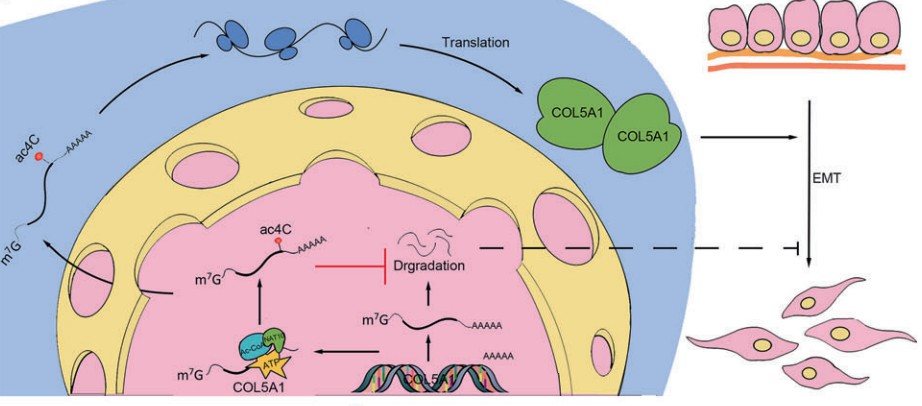COL5A1 and Associated Diseases
Description of COL5A1
Type V collagen was first identified in the human placenta and adult skin, but later studies showed that it is present in many other tissues and organs as a minor collagen component. Type V collagen usually presents as heterotrimers of 3 different polypeptide chains, α-1, α-2, and α-3, or 2 copies of α-1 and 1 copy of α-2; or it also exists as a homotrimer of α-1 polypeptides. In humans, the COL5A1 gene on chromosome 9q34.3 encodes collagen alpha-1(V) chain protein, a member of fibrillar collagen with low abundance. Compared with other fibrillar collagen genes, the COL5A1 gene is more complex containing 66 exons and spanning at least 750 kb.
Both collagens V and XI have a fundamental role in the control of fibrillogenesis, probably by forming a core within the fibrils. These two collagens are usually buried within the major collagen fibrils, containing both cell adhesion and heparin-binding sites that are crucial in physiologic processes such as development and wound healing.
COL5A1 and Related Disorders
COL5A1 is one of the collagen members with minor content but prominent functions. As a collagen family protein, COL5A1 is involved in extracellular matrix formation. Bioinformatic identification indicates that abnormal expression of COL5A1 may be a key factor in the occurrence of lesions in many tissues, including breast, gastric, ovarian, oral, and lung.
- Gastric Cancer
Gastric cancer (GC) is one of the most prevalent gastrointestinal malignancies. NAT10 (N-Acetyltransferase 10) is thought to have critical effects on tumor metastasis and tumor cell epithelial-to-mesenchymal transition (EMT). Research (Zhang, 2021) indicated that COL5A1 was a direct target of NAT10. The expression of COL5A1 was significantly elevated in GC tissues, and patients with high COL5A1 expression were associated with poor survival. These indicated that COL5A1 may play a promoting role in metastasis and EMT of GC.
 Fig.1 The promoting roles of NAT10 and COL5A1 in the metastasis and EMT of GC. (Zhang, 2021)
Fig.1 The promoting roles of NAT10 and COL5A1 in the metastasis and EMT of GC. (Zhang, 2021)
- Aortic Dissection
Aortic dissection (AD) is one of the most life-threatening cardiovascular diseases that exhibit high genetic heterogeneity. The sequence kernel association test (Chen, 2021) performed on the COL5A1 gene between the Aortic dissection patients and healthy individual groups revealed that the likely pathogenic variants in the COL5A1 gene were significantly enriched in patients with Aortic dissection. Furthermore, in the Aortic dissection animal models, Col5a1 knockout rats were predisposed to higher Aortic dissection incidence and mortality compared with wild-type rats. Subsequent mechanism analysis revealed that Col5a1 knockout partially caused Aortic dissection by activating the TGF-β signaling pathway.
- Ovarian cancer
Ovarian cancer (OC) remains the leading cause of cancer-related death among gynecological cancers. It has been demonstrated (Zhang, 2021) that COL5A1 expression was much higher in OC cells and tissues, and the knockdown of COL5A1 inhibited the proliferation and migration of OC cells. Survival analysis predicted that the elevated COL5A1 expression was associated with a worse survival outcome and correlated to the tumor stage of OC patients. The estimating relative subsets of RNA transcripts algorithm analysis also unveiled the correlation of several tumor-infiltrating immune cells with the expression of COL5A1.
- Gliomas
Glioma is the most common malignancy of the central nervous system. The overexpression of COL5A1 was indicated to be positively correlated with increasing tumor malignancies and poor prognosis in gliomas. And downregulation of COL5A1 could inhibit the proliferation and migration of glioma cells (Gu, 2021).
Creative Biolabs provides easily accessible and actionable solutions for the most challenging gene therapy projects. Our business model prioritizes the best overall result over the lowest-ranked price. If you are interested in our services or studying the role of COL5A1 in development and disease, please feel free to contact us for more.
Reference
- Zhang, Y.; et al. NAT10 promotes gastric cancer metastasis via N4-acetylated COL5A1. Signal transduction and targeted therapy. 2021, 6(1): 173. Distributed under Open Access license CC BY 4.0, without modification.
